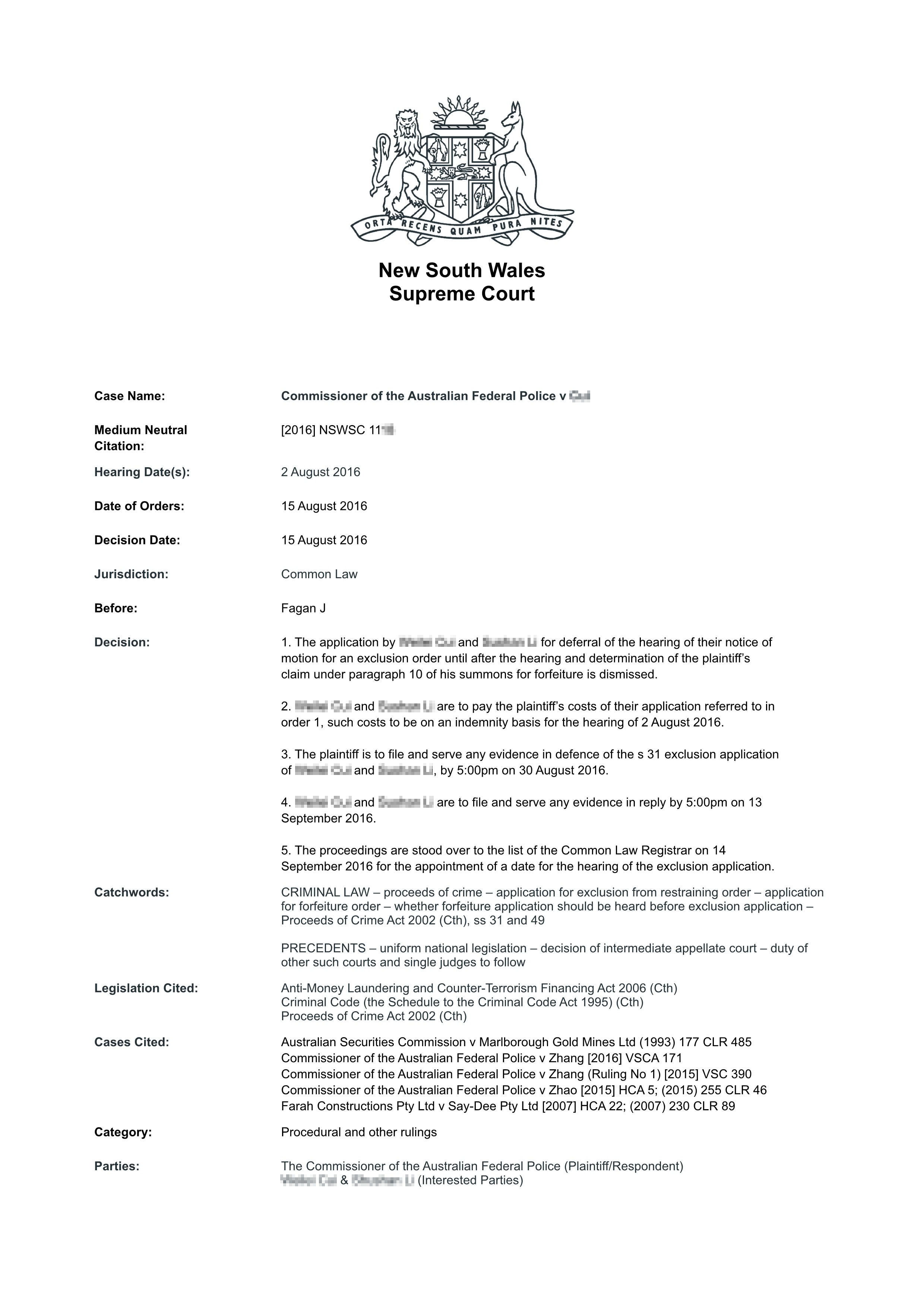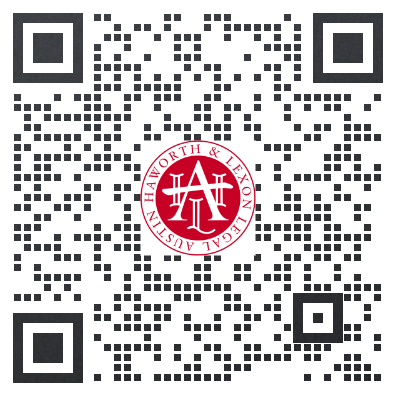【海量案例】Commissioner of the Australian Federal Police v CXX [2016] NSWSC 1XX8


JUDGMENT
These proceedings have been brought by the Commissioner of the Australian Federal Police (“AFP”) under the Proceeds of Crime Act 2002 (Cth). On 1 December 2015 the Court made a restraining order pursuant to s 19 of that Act upon the application of the Commissioner in respect of $199,990 in cash which had been seized by AFP agents on 11 March 2015. The interlocutory issue now before the Court concerns the sequence in which two substantive applications should be heard, one being an application for exclusion of the cash from the restraining order (s 31) by persons interested in that property and the other being a claim by the AFP for an order forfeiting the cash to the Commonwealth (s 49).
On 11 March 2013 at approximately 1:00pm WeXXei CXX, a female, was observed by Federal Agent Burtenshaw to enter the World Square branch of the National Australia Bank (“NAB”) in Sydney. She was carrying a black bag which she took into an office adjacent to the public area of the banking chamber. In the office Ms CXX unpacked from the black bag bundles of Australian currency notes totalling $199,990. Shortly afterwards she was joined in the office by BeX JiXXg, a female.
Federal Agent Burtenshaw intervened in the dealings between WeXXei CXX and BeX JiXXg and NAB personnel. He introduced himself and shortly after he was joined by Federal Agent Blunden. From 1:55pm Federal Agent Burtenshaw conducted a record of interview with WeXXei CXX in which he obtained explanations of how she came to be in possession of the cash. He regarded the explanations as unsatisfactory and implausible.
At approximately 2:39pm SuXXan LX, the husband of WeXXei CXX, attended the bank. Federal Agent Blunden interviewed him and obtained his explanations of the origins of the cash. These were inconsistent with the explanations offered by Ms CXX and they involved internal contradictions. Shushan Li terminated the interview with Federal Agent Blunden in a state of agitation. He was escorted from the bank by police. The cash was seized by the Federal agents.
The AFP subsequently examined international passenger movement records for WeXXei CXX, SuXXan LX and others, reviewed records of the Australian Transactions Reports and Analysis Centre (“AUSTRAC”), undertook real property and company searches and made enquiries with four banks. They considered correspondence from a solicitor acting on behalf of CXX and Li. At the end of these enquiries Federal Agent Burtenshaw held a suspicion that the seized cash was either the proceeds of, or an instrument of, one or more serious offences.
The offences in the officer’s contemplation were breach of s 400.9 Criminal Code (the Schedule to the Criminal Code Act 1995 (Cth)) (dealing with money reasonably suspected to be proceeds of crime) and breach of s 53 Anti-Money Laundering and Counter-Terrorism Financing Act 2006 (Cth) (“the Money Laundering Act”) (moving currency not less than $10,000 into or out of Australia without report). Those are indictable and serious offences within the meaning of subpars (i) and (ii) of s 19(1)(d) Proceeds of Crime Act. It was on the basis of Federal Agent Burtenshaw’s suspicions that the restraining order over the cash was made by the Court on 1 December 2015.
The Commissioner’s summons filed 2 October 2015 seeks at par 10 an order for forfeiture of the $199,990 cash, pursuant to s 49 Proceeds of Crime Act. That aspect of the summons should be listed for hearing as soon as all interlocutory processes relating to the summons have been completed. The pre-requisites for the making of a forfeiture order are, first, that it is applied for by “the responsible authority for a restraining order under section 19 that covers the property” (s 19(1)(a)). This requirement is satisfied because the Commissioner is such a responsible authority. Secondly, it is required that a restraining order should have been in place for six months (s 49(1)(b)), which again has been satisfied. Thirdly and fourthly, by operation of pars (c) and (e) of s 49 (1):
“(c) the court is satisfied that one or more of the following applies:
(i) the property is *proceeds of one or more *indictable offences;
(ii) the property is proceeds of one or more *foreign indictable
offences;
(iii) the property is proceeds of one or more *indictable offences of
Commonwealth concern;
(iv) the property is an instrument of one or more *serious offences; and
(e) the court is satisfied that the authority has taken reasonable steps to
identify and notify persons with an *interest in the property.”
With respect to the third prerequisite set out in par (e) quoted above, it is provided by subs (2) that this does not require that the Court should find a particular person committed any offence or that any particular offence was committed. It would be sufficient for the Court to be satisfied that “some offence or other of a kind referred to in paragraph 1(c) was committed”.
Subsection (3) of s 49 is in these terms:
“(3) Paragraph (1)(c) does not apply if the court is satisfied that:
(a) no application has been made under Division 3 of Part 2-1 for the property to be excluded from the *restraining order; or
(b) any such application that has been made has been withdrawn.”
Division 3 of Pt 2-1 comprises ss 29-32. In this case WeXXei CXX and SuXXan LX (“the Applicants”) filed on 7 December 2015 a notice of motion seeking orders pursuant to ss 29 and 31 of the Act that the seized cash be excluded from the restraining order. As the cash is the only property restrained, if this exclusion order should be made there would be nothing left under restraint which could be forfeited under s 49. The Applicants’ notice of motion also claimed revocation of the restraining order, however that paragraph of the notice of motion was dismissed by consent on 25 May 2016.
The Applicants now seek directions for the exchange of evidence in relation to the Commissioner’s claim for a forfeiture order under his summons and they ask that the date be appointed for hearing that application. They seek to have the forfeiture application heard before their own notice of motion for exclusion. That sequence of procedure would be illogical, inappropriate and contrary to the Applicants’ own interests. Should the Commissioner succeed in his forfeiture application the cash would vest “absolutely in the Commonwealth at the time the [forfeiture] order is made” (s 66). The restraining order would thereafter no longer be operative and the Applicant’s application for an order to exclude the cash from its reach would be futile.
In Commissioner of the Australian Federal Police v Zhang (Ruling No 1) [2015] VSC 390 T Forrest J of the Supreme Court of Victoria had before him for hearing both an application by the AFP for forfeiture orders and applications by two parties, Zhang and Shen, for exclusion orders in respect of certain property. His Honour decided at [33] that he should hear the forfeiture application first: “Should it be successful I will then hear the exclusion applications. Should it be unsuccessful it will not be necessary to hear those applications.” His Honour considered this course preferable as a matter of procedural fairness because it would require the Commissioner to go first in evidence, in support of his case on forfeiture. If the Commissioner should fail to make out this case, particularly in relation to par 1(c) of s 49, then the parties seeking exclusion orders would not need to press their application and need not go into evidence. In arriving at this decision his Honour placed considerable reliance upon reasoning in Commissioner of the Australian Federal Police v Zhao [2015] HCA 5; (2015) 255 CLR 46 at [29] and [37], a case in which the High Court considered the procedural disadvantages to an accused person if a forfeiture application in respect of property claimed by the accused should be heard in advance of that person’s trial on criminal charges. In the event his Honour dismissed the forfeiture application after hearing it first and therefore did not need to consider the exclusion application.
The decision of T Forrest J was handed down in August 2015. It was referred to in correspondence between the solicitors for the Commissioner and for the Applicants, respectively, in late May and early June 2016. On 2 June 2016 the Court ordered that the Applicants serve by 29 June 2016 submissions concerning the sequence in which the completing applications should be heard. The summons and the Applicants’ motion were listed before the duty judge on 2 August 2016 for this question to be resolved. Submissions dated 29 June 2016 were served on about that date but not filed. They relied heavily on T Forrest J’s judgment.
On 22 July 2016 the full bench of the Victorian Court of Appeal granted leave to the Commissioner of the AFP to appeal T Forrest J’s decision and allowed the appeal: Commissioner of the Australian Federal Police v Zhang [2016] VSCA 171. In a joint judgment the Court held that his Honour had erred in relying upon Commissioner of the Australian Federal Police v Zhao, thereby introducing concepts of procedural fairness which could not prevail over the clear structure and operation of the Proceeds of Crime Act. The following extracted paragraphs of the Court of Appeal’s judgment explain the Court’s reasoning sufficiently for consideration of its application to the present case (footnotes and references have been removed):
“[71] In our opinion, the orders dismissing the forfeiture applications are not interlocutory. They are final orders. The effect of the orders is that none of the Canterbury property, the Mercedes, or the Ashwood property is subject to any restraining order under the Act. The restrained property is released. There are no further steps to be taken towards a final disposition of the proceeding at first instance.
[72] We consider that Ruling No 1, and the consequential orders, were made in error. The sequence adopted by the judge was erroneous and the source of the error lay in the judge’s misconstruction of the Act. Upon its proper construction, the Act required the judge to determine the s 31 exclusion applications before determining the forfeiture applications. The error arose because the judge was persuaded that a beneficial reading of the Act which favoured Zhang and Shen should be preferred to a plain reading of the text of the Act.
[73] In our view, Zhang and Shen, in submitting that there was nothing impermissible about the sequence adopted by the judge because, if necessary, the exclusion applications (or, more particularly, the s 31 exclusion applications) could be heard after the making of any forfeiture orders and the result ‘would have been the same’, have elided the difference between exclusion applications made pursuant to s 31 of the Act and exclusion applications made pursuant to s 74 of the Act. It is necessary in construing the Act to be mindful that exclusion applications made pursuant to s 31 of the Act are applications to exclude property (or an interest in property) from the operation of restraining orders; whereas exclusion applications made pursuant to s 74 of the Act are applications made to exclude property (or an interest in property) from the operation of forfeiture orders. The distinction between the effect of restraining orders and forfeiture orders is critical.
[74] While restraining orders have the effect of restricting the exercise of rights of ownership over property in the interim, forfeiture orders exhibit a degree of finality. As noted, s 66 of the Act provides that property specified in a forfeiture order vests absolutely in the Commonwealth at the time the forfeiture order is made. In other words, forfeiture orders effect a transfer of ownership in property. While s 73 exclusion orders from forfeiture may be determined after a forfeiture order is made, this is because the Act makes express accommodation for directions, after the property has vested in the Commonwealth, for the Commonwealth to transfer the interest to the applicant, pursuant to s 73(2)(c), or, if the property has been disposed of, for the Commonwealth to pay the applicant an amount equal to the value of the interest concerned, pursuant to s 73(2)(d). There is no such accommodation made under the Act, post forfeiture, in respect of exclusion applications from restraining orders under s 29. This is so for the very reason that the Act envisages that exclusion applications from restraining orders will have been dealt with before forfeiture applications are heard and determined. In other words, if a forfeiture application is successful — and that possibility must always be open at the time a court embarks upon the hearing of the application — there will be no utility in persisting with an exclusion application from an earlier restraining order because the property will have vested in the Commonwealth and the Act makes no provision for reverse transfers in ownership or monetary compensation with respect to an order made under s 29 excluding property from restraining orders.
[75] Similarly, as was observed by the NSW Court of Appeal in Studman v Director of Public Prosecutions (Cth), once a forfeiture order has been made and the relevant property vests in the Commonwealth, any appeal against the rejection of an application to exclude property (or an interest in that property) from the operation of the restraining order is futile.
[76] Once the judge in the present case heard and determined the forfeiture applications, there could never have been any occasion upon which he might subsequently hear and determine the s 31 exclusion applications. If the forfeiture applications were refused then that would have been the end (as it turned out to be) of the operation of the restraining orders. On the other hand, if the forfeiture applications were granted then that too would have been the end of the restraining orders. All that would have been left for the Court to do was to hear and determine the s 74 exclusion applications (being the applications to exclude the relevant property from the operation of the forfeiture orders). In effect, the judge, by adopting the sequence he did, never allowed for the possibility that he would deal with, and dispose of, the s 31 exclusion applications. It became inevitable that the s 31 exclusion applications would never be dealt with by the Court. In our view, this was contrary to the intended operation of the Act.
[77] The making, and maintaining, of exclusion applications under s 31 of the Act has important consequences as set out in s 49(3) of the Act. It would serve no purpose to require a party to make a s 31 exclusion application (and have that application remain on foot during the hearing of a forfeiture application) merely so as to require the Commissioner to establish one of the matters set out in s 49(1)(c) of the Act. If the submissions of Zhang and Shen were to be accepted then, in order to ensure that s 49(1)(c) applies (and one of the four matters therein is required to be proved by the Commissioner), all a respondent to a forfeiture application would need to do would be to issue and maintain an exclusion application, made under s 31 of the Act, that would never ultimately have to be heard or determined. Put another way, if general considerations of ‘fairness’ require the Commissioner to ‘go first’, as the judge concluded, once a forfeiture application has been made, then a ‘protective’ exclusion application could be made under s 31 of the Act. Such an application would never be heard or determined: its only purpose would be to disengage s 49(3) of the Act. An applicant for exclusion under s 31 would thereby obtain a substantial benefit from the application without ever having to discharge the onus associated with it.
[78] Nothing in the Act suggests that it was the intention of the Parliament that parties be permitted to make applications to a court that will never be heard or ruled upon. One would be very slow to embrace a construction of any Act of Parliament that required or permitted parties to make applications to courts, and thereby to consume valuable public resources in pursuing such applications, in circumstances where general notions of fairness or case management principles would ultimately require orders to be made that would have the effect of those applications never being heard and determined on their merits.
...
[81] Under the Act, Zhang and Shen were either required to pursue the s 31 exclusion applications before the forfeiture applications were determined, or to withdraw the s 31 exclusion applications. The Act does not allow for s 31 exclusion applications to be kept on foot, with the consequence that s 49(3) is deprived of any operation, without determination.
[84] Finally, on the question of sequence, it is necessary to consider the logic underlying the Act. As forfeiture orders are made under s 49 over restrained property, the first step for the court must be to identify the scope of the restraining order. Where a s 31 exclusion application has been made this requires the court to identify what property remains within the scope of the restraining order after the s 31 exclusion application has been heard and determined. It is that remaining scope which identifies the property to be forfeited. It follows that an exclusion application must be determined before the court considers whether the property should be forfeited pursuant to s 49(1)(c).” [Footnotes omitted]
The Proceeds of Crime Act being Commonwealth legislation I am bound to follow the Court of Appeal’s interpretation and application of it unless convinced that their decision is plainly wrong: Australian Securities Commission v Marlborough Gold Mines Ltd [1993] HCA 15; (1993) 177 CLR 485 at 492; Farah Constructions Pty Ltd v Say-Dee Pty Ltd [2007] HCA 22; (2007) 230 CLR 89 at [135]. Far from being convinced that the decision is plainly wrong, I respectfully agree with it. Following the court’s interpretation of the Proceeds of Crime Act I hold that it does not permit the Applicant’s s 31 exclusion application to be kept on foot for hearing and determination after the Commissioner’s forfeiture application: [81].
The Applicants’ evidence in support of their exclusion application is closed. Apart from dismissing their application regarding the sequence of proceedings and providing for the costs thereof, the only other orders required are directions for filing and service of any evidence from the Commissioner with respect to the s 31 exclusion application and for evidence from the Applicants in reply. The proceedings must then be referred to the registrar to fix a date for hearing of the Applicants’ exclusion application.
The Applicants’ solicitors were informed by letter of 28 July 2016 from the Commissioner’s solicitors of the Victorian Court of Appeal’s decision. It has been determinative of their application regarding the sequence of hearings. This letter was sent by email at 12:20pm that day, 2½ clear business days prior to the hearing which was listed before me on 2 August 2016. The Applicants should then have promptly abandoned their application regarding the sequence of hearings. By their own enquiries they could have ascertained earlier than 28 July that the decision of T Forrest J upon which they relied had been overturned.
Even after I pointed out to the Applicants’ counsel in argument that I would be bound to follow the Victorian Court of Appeal and offered him an adjournment for part of the day to consider that court’s reasons (which he apparently had not yet done) the application with respect to the sequence of hearings was pressed. After I gave the Applicant’s counsel leave to deliver written submissions to my chambers as he was not prepared to argue the matter when it was called on 2 August 2016, the only submissions sent were those dated 29 June 2016 which had been entirely superseded by the overturning of T Forrest J’s decision. The submissions were sent unamended with no attempt to argue why the Victorian Court of Appeal’s reasoning should not be followed. In those circumstances the costs of the hearing of the application on 2 August should be paid on an indemnity basis.
The orders of the Court are:
(1) The application by WeXXei CXX and SuXXan LX for deferral of the hearing of their notice of motion for an exclusion order until after the hearing and determination of the plaintiff’s claim under paragraph 10 of his summons for forfeiture is dismissed.
(2) WeXXei CXX and SuXXan LX are to pay the plaintiff’s costs of their application referred to in order 1, such costs to be on an indemnity basis for the hearing of 2 August 2016.
(3) The plaintiff is to file and serve any evidence in defence of the s 31 exclusion application of WeXXei CXX and SuXXan LX, by 5:00pm on 30 August 2016.
(4) WeXXei CXX and SuXXan LX are to file and serve any evidence in reply by 5:00 pm on 13 September 2016.
(5) The proceedings are stood over to the list of the Common Law Registrar on 14 September 2016 for the appointment of a date for the hearing of the exclusion application.
**********



 1300 91 66 77
1300 91 66 77







 首页
首页


